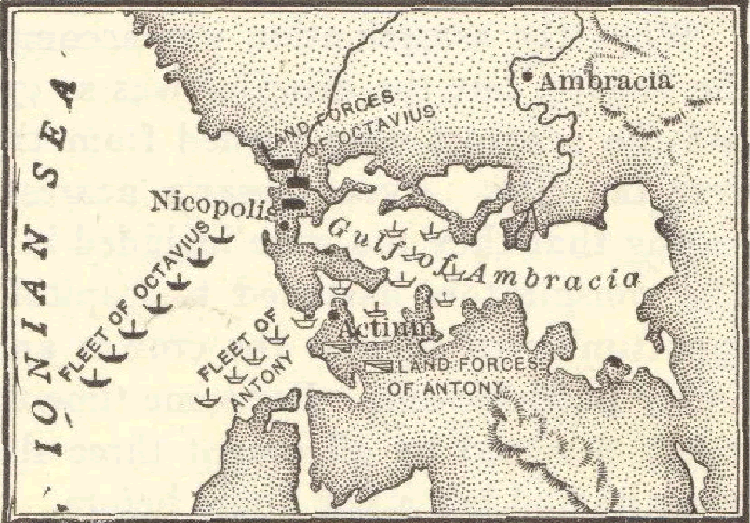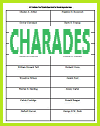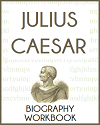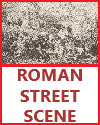Map of the Battle of Actium: Fleet and land forces of Octavius. Fleet and land forces of Antony and Cleopatra. Click here to enlarge this map.
The Battle of Actium was a significant naval battle fought on September 2, 31 BCE, between the forces of Octavian (the future Emperor Augustus) and those of Mark Antony and Cleopatra of Egypt. This battle marked a pivotal moment in the Roman Republic's transformation into the Roman Empire.
Background: The Roman Republic had been torn by internal strife and civil wars in the years leading up to the Battle of Actium. Two powerful and charismatic Roman leaders, Octavian (also known as Gaius Octavius and later Augustus) and Mark Antony, formed the Second Triumvirate along with Marcus Aemilius Lepidus to restore order to Rome. However, the alliance soon disintegrated.
Causes: The conflict between Octavian and Mark Antony was exacerbated by their personal and political differences. Mark Antony's relationship with Cleopatra, the Queen of Egypt, was a significant point of contention, as many Romans viewed it as a threat to Roman sovereignty.
Forces:
- Octavian's fleet was commanded by his admiral, Agrippa, and included a well-disciplined and organized navy.
- Mark Antony and Cleopatra's fleet was a mixture of Roman and Egyptian ships. Antony's leadership and the loyalty of his troops were questioned due to his association with Cleopatra.
The Battle:
- The Battle of Actium was fought in the Ionian Sea, off the western coast of Greece. Octavian's forces used a combination of tactics, including the use of fireships (ships set on fire and directed toward the enemy) and encirclement to gain the upper hand.
- The battle was characterized by confusion and defections within Mark Antony's fleet, as some of his captains and soldiers abandoned him. Cleopatra's fleet attempted to escape the battle prematurely.
- The decisive moment came when Cleopatra's flagship, trying to escape, was pursued by Octavian's ships. Mark Antony, believing that Cleopatra had been killed or captured, attempted to follow her and broke through the enemy lines.
- Seeing Mark Antony's flight, his remaining ships surrendered, and Octavian emerged victorious.
Outcome:
- The Battle of Actium marked the end of the Roman Republic, as Octavian's victory over Mark Antony and Cleopatra led to his consolidation of power and the eventual establishment of the Roman Empire. Octavian became the undisputed ruler of the Roman world and later took the title of Augustus, the first Roman Emperor.
- Mark Antony and Cleopatra fled to Egypt, where they committed suicide rather than face capture.
- Egypt was annexed as a Roman province, and the last Ptolemaic ruler, Cleopatra, ended the Ptolemaic dynasty, which had ruled Egypt for nearly three centuries.
The Battle of Actium is significant for its role in the transition from the Roman Republic to the Roman Empire. It solidified Octavian's position as the sole ruler of Rome and set the stage for the Augustan Principate, a period of relative stability and prosperity in Roman history.
|















